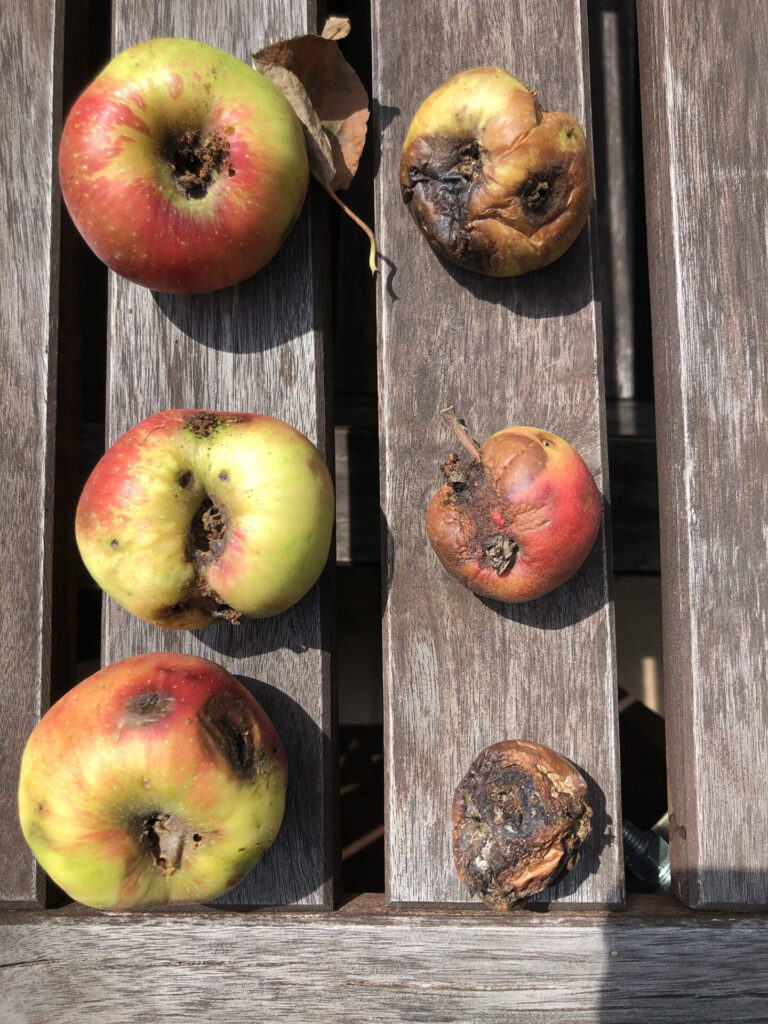
I have 1 Honeycrisp and 1 Empire Apple tree in my backyard. I’ve had trouble in the past with codling moth – they are a problem every year. I put out molasses and cider traps in the spring along with wrapping cardboard around the trunks but it doesn’t seem to do the trick. This year absolutely every single apple was ruined. I picked them all and disposed of them back in early August. I’m out of ideas and techniques.
Help!
Thanks,
Jeff
Oh the frustration you must feel! It can be pretty disappointing when a pest or disease interrupts a harvest. Codling moth also known as Cydia (Laspeyresia) pomonella, can be very difficult to manage. Having an understanding of the lifecycle is a good place to start and I found an excellent description on the University of California Agriculture and Natural Resources website:
“Codling moth overwinters as full-grown larvae within thick, silken cocoons under loose scales of bark and in soil or debris around the base of the tree. The larvae pupate inside their cocoons in early spring and emerge as adult moths mid-March to early April. The moths are active only a few hours before and after sunset, and they mate when sunset temperatures exceed 62°F.
After mating each female deposits 30 to 70 tiny, disc-shaped eggs singly on fruit, nuts, leaves, or spurs. After the eggs hatch, young larvae seek out and bore into fruit or developing nuts. After completing development they leave the fruit and drop from the trees to search out pupation sites and continue the life cycle in the soil or on debris under the tree; some crawl back up the tree to pupate in bark crevices.
The rate of development will vary with temperature, proceeding more rapidly in warmer weather and climates. Depending on the climate, codling moth can have two, three, and sometimes four generations per year.”
Since the trapping and trunk banding has not proved successful for you, there are two other non-chemical control suggestions. The first is cleaning/sanitation. It is suggested that every week to two weeks that you monitor and remove any fruit showing signs of infestation. By removing the fruit before the larvae emerge you can significantly reduce the population. It is equally important to remove any dropped fruit on the ground as they could be infested too.
The second method is bagging the fruit. This one sounds a bit more labour intensive but claims to be an excellent control of the moth. It is done by enclosing young fruit in bags right on the tree. This is the only nonchemical control method that is effective enough to be used alone and in higher population situations. It is suggested that bagging be done about four to six weeks after bloom when the fruit is from 1/2 to 1 inch in diameter. Use the standard lunch bag size that measures 7 1/4 inches by 4 inches, cut a 2-inch slit in the bottom fold of each bag. Thin the fruit to one per cluster. Slip the thinned fruit through the 2-inch slit so that it forms a seal around the stem and staple the open end shut.
In terms of spray applications, I came across a product called Virosoft CP4 which is recognized for use in organic production and is OMRI (Organic Materials Review Institute) listed. It is approved in Canada and the United States. For further information and where to get this product, please see here https://biotepp.com/virosoft/?lang=en
I hope this is helpful to you and I wish you lots of apples next year.
October 5, 2023

